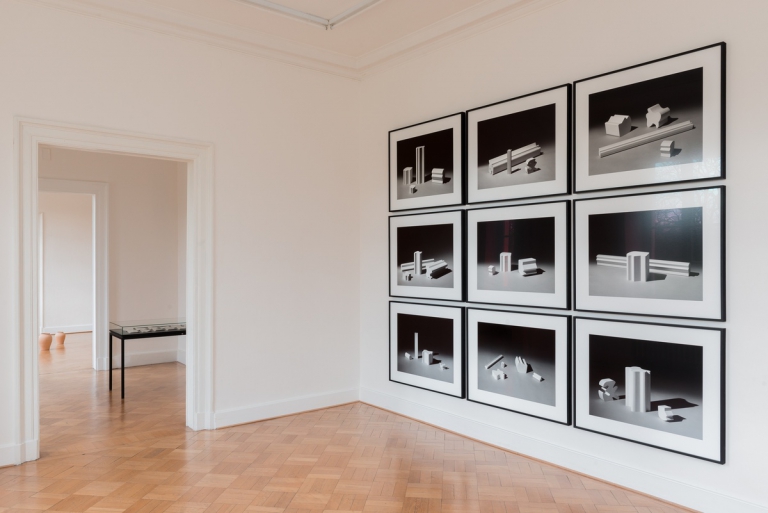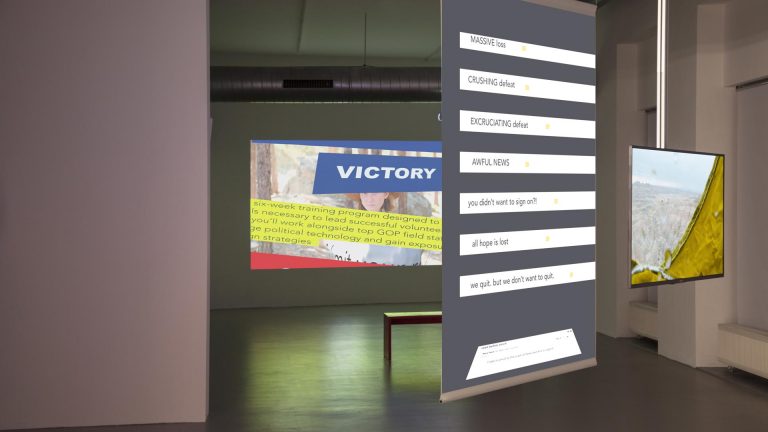Artist: Roy Mordechay
Exhibition title: Somewhere Between the Tropic of Cancer and the Tropic of Capricorn
Venue: Nir Altman, Munich, Germany
Date: October 20 – December 1, 2018
Photography: all images copyright and courtesy of the artist and Nir Altman, Munich
Roy Mordechay’s works are inextricably linked to his cultural-anthropological examination of imagery and motifs, which motivates a sensual play of figures, lines and shapes. Inspired by narratives of his biography, which range from first memories as a child to his current nomadic life moving between Düsseldorf and Tel Aviv, he enriches his actual abstract compositions with detailed symbols. While looking at these works it occurs the irredeemable desire to bring all individual parts together in a meaningful narrative. This enthralling game between the emergence of a concrete landscape or figure and the simultaneous free flow of the visual motifs goes back to the artist’s calculation. For Mordechay it is about the interstices of his works in form and content: ,,(…) between the lines. Touching and not touching.”
The new paintings and sculptures of Roy Mordechay’s solo show illustrate once more his aspiration to draw unclear spaces, in which an explaining narrative cannot be grasped, into his compositions. An intrinsic visual interaction gains momentum moving between attribution and denouement as well as touch and withdraw—an appealing dialectic. This dynamic also transfers to the formal aspects of his works. The border between a canvas and a three-dimensional object is partially fluent.
The large-scale work We Are Here to Laugh at the Odds is comprising almost the whole long side of the exhibition room. Thereby the painting’s surface takes over the proportions of the gallery space, it almost becomes a mural on its own. This impression tips as the canvas comes off its flatness and turns into the three-dimensional space. What is partially suggested as spatial depth with figures and forms on the painting’s surface is being extended by the canvas as an object. The wooden, rough framework of the canvas is equally a part of the composition as the painted front. Thereby the work obtains its sensual appeal not only from the contrast between painterly surface and sculptural objectuality. The abstract shapes and lines constitute within the pictorial space a freely floating mesh, which is loosely retained through a grid in the background shimmering through the transparent paint layers. At the same time, also figurative allusions are placed within the work as for instance when small faces or heads appearing so characteristically and plastically within the pictorial space that you directly attempt to put them in coherent, narrative order. As you are thrown back onto the overall, large-scale composition, these representational moments vanish into the free, abstract flux of shapes and lines as they immediately emerged.
From Within the Erased Indigo from the “Palette Mood” series comprises one of Mordechay’s former chipboard palettes which was upgraded to a three-dimensional object by grinding and rounding it off. Though the work figures as a sculpture it also shows sketched and painted elements. By grinding off old layers of paint while some parts remain, Mordechay makes the past painting process a feature of his story as an artistic personality. With few lines and smooth, vigorous brushstrokes he reinterprets these painterly traces towards new compositions, as here the mask with its hidden book behind which also reveals the artist’s humoristic approach. An addition of the mask which leads in turn to narrative speculation is the ‘bookend’, mounted behind the palette. Penned in a rugged wood construction an image of a book about Latin-American mysticism and folklore is being framed. Thereby the mask with its shadowy eyes and mouth seems like a portal to an uncertain associative world.
Exceptional is also Mordechay’s way of handling and crafting wood in these new works. He is not only manufacturing his pedestals and bases from mostly pretreated, industrial timber. This pliable material is also used for sculptures such as Ein Shem (There Is No “There” There). Appearing as a hybrid of wander stick and ornately root branches, the buoyant form and the color of the sculpture distracts from the fact that it comprises a myriad of single pieces. The work is made of the ‘bones’ of his paintings, as Mordechay calls them. Thereby ‘bones’ are the wooden rests of frames when the artist produces his canvasses. From industrial material, almost figuring as a ready-made, and shaped through sandpaper and painted with black ink it arises a very formalistic but also poetical object. Even here exists an ambiguity which alternates between the primal, plain roughness of the material and the newly crafted design. The interaction between the original, planar roughness of the material and the newly crafted, plastic object yields an ambiguous sculpture. Despite all the rawness of the industrially pressed timber the stained and ground framework-piece seems like a precious artefact, which evokes the image of an ancient treasure. Yet, the snake-like sculpture functions as an extension of the line in Mordechay’s paintings. Ein Shem forms a spatial correspondence towards the line compositions in We Are Here to Laugh at the Odds. Though it expands the sculptural line with an arabesque which again triggers a potential narrative. Even here the moment of clarification is not being redeemed in favor of a suspenseful, desirable image.
The work I Will Sing While You Croak is meant to be a kind of greeting prelude of Roy Mordechay’s exhibition tour, which can be seen as a ‘mental gate’ to the spectator. Mentioning the work at the end of this text it seems to be placed in the wrong way—or it can be used to feel and understand the show, as an epilog. Although one could think of a more conceptual work marked through the wooden base and thereon positioned an A4 paper sheet with a literary quote on it, this piece is one of the emotional works of the whole show. Commencing with the massive, aged wooden block the sheet of paper seems as just now leaned against the wall. In the next second, it could get carried away by one slight gust. In this poetic, from contrasts created arrangement Henry Miller’s quote helps to understand Mordechay’s “between the lines” in a deeper sense. “It is not necessary to have an accordion, or a guitar. The essential thing is to want to sing. This then is a song. I am singing.“
by Franziska Wilmsen
Roy Mordechay, Somewhere Between the Tropic of Cancer and the Tropic of Capricorn, 2018, exhibition view, Nir Altman, Munich
Roy Mordechay, Somewhere Between the Tropic of Cancer and the Tropic of Capricorn, 2018, exhibition view, Nir Altman, Munich
Roy Mordechay, Somewhere Between the Tropic of Cancer and the Tropic of Capricorn, 2018, exhibition view, Nir Altman, Munich
Roy Mordechay, Somewhere Between the Tropic of Cancer and the Tropic of Capricorn, 2018, exhibition view, Nir Altman, Munich
Roy Mordechay, We are here to laugh art the odds, 2018, Oil, acrylic, pencil and watercolor on canvas, 800×250 cm
Roy Mordechay, We are here to laugh art the odds, 2018, Oil, acrylic, pencil and watercolor on canvas, 800×250 cm
Roy Mordechay, I will sing while you croak, 2018, 4A paper watercolor and ink on wood, 33.5x28x7.5 cm
Roy Mordechay, “Ein Shem” ( There is no “there” there”), 2018, Watercolor, ink and lack on wood, 150 x 120 cm
Roy Mordechay, “Ein Shem” ( There is no “there” there”), 2018, Watercolor, ink and lack on wood, 150 x 120 cm
Roy Mordechay, Holy, 2018, Oil, acrylic, pencil and watercolor on canvas, 27.7×19.7 cm
Roy Mordechay, Visitors, 2018, Oil, acrylic, pencil and watercolor on canvas, 33.5×25.5 cm
Roy Mordechay, From Within, 2018, Wood, oil paint, spray and a book, 44x28x113 cm; Holy, 2018, Oil, acrylic, pencil and watercolor on canvas, 27.7×19.7 cm
Roy Mordechay, From Within, 2018, Wood, oil paint, spray and a book, 44x28x113 cm
Roy Mordechay, From Within, 2018, Wood, oil paint, spray and a book, 44x28x113 cm




















